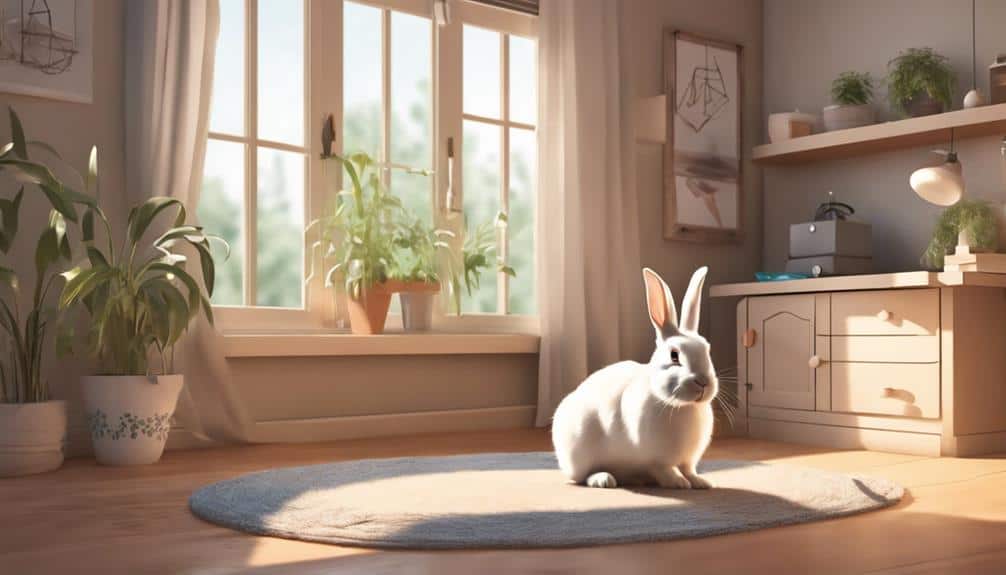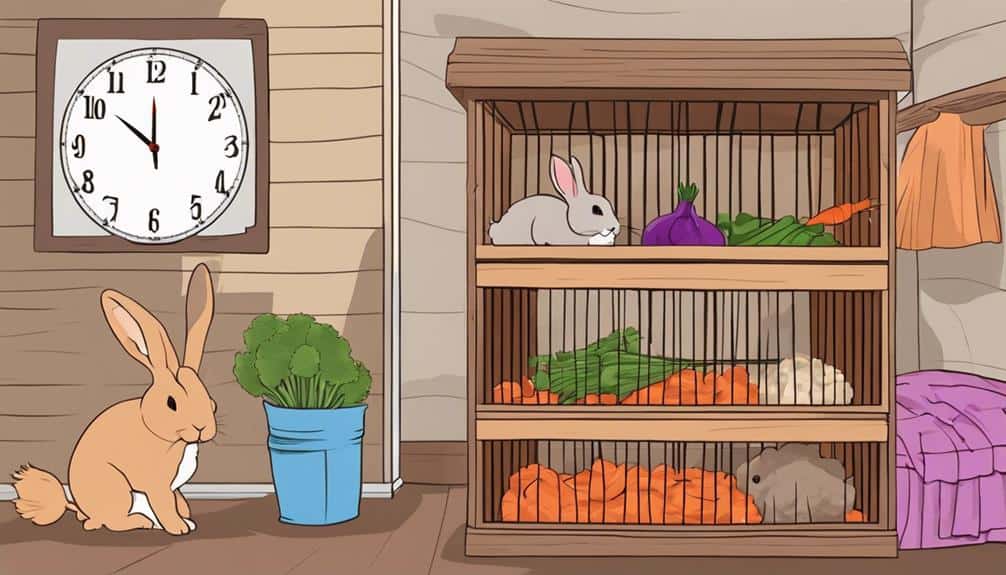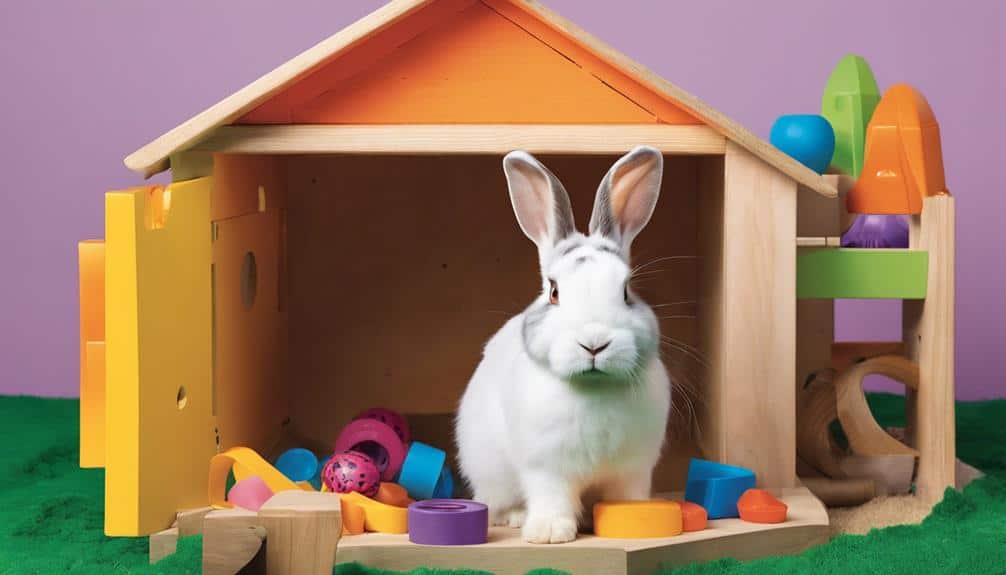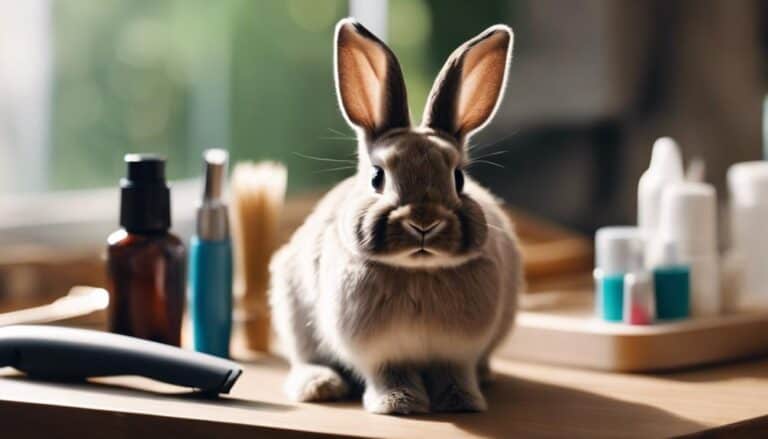Did you know that approximately 40% of house rabbits experience stress-related health issues at some point in their lives? Ensuring the well-being of your furry companions is essential for their happiness and longevity.
By implementing simple yet effective strategies, you can create a harmonious environment that promotes relaxation and contentment for your house rabbits. From providing a safe and quiet space to engaging them with stimulating activities, there are various ways to minimize stress and enhance the quality of life for your beloved pets.
Contents
Key Takeaways
- Provide a quiet and serene environment to reduce stress.
- Establish a consistent routine for feeding and bedtime.
- Watch for signs of stress like hiding or aggressive behavior.
- Offer a balanced diet and a stimulating living space for well-being.
Provide a Quiet Environment

To guarantee the well-being of your house rabbit, creating a serene and quiet environment is essential to minimize stress and promote a sense of security. Rabbits are incredibly sensitive creatures, and loud noises can have a significant impact on their overall health and happiness. Excessive noise can lead to fear and anxiety in rabbits, affecting their behavior and well-being. By keeping the environment calm and free of loud disturbances like loud TV volumes or slamming doors, you can create a peaceful space where your rabbit can feel safe and secure.
A quiet setting allows rabbits to relax and unwind, reducing the risk of stress-related health issues. Providing a tranquil environment not only benefits your rabbit's mental and emotional state but also contributes to their physical health. By being mindful of the noise levels in your rabbit's surroundings, you're actively promoting a harmonious space where your furry friend can thrive and be at peace.
Create a Safe and Comfortable Space
Creating a safe and comfortable space for your house rabbit is crucial for their well-being and happiness. Here are some tips to help you set up the perfect environment for your furry friend:
- Provide Ample Space: Ensure the enclosure is at least 12 square feet for a single rabbit to have enough room to move around freely and exercise, reducing stress levels.
- Include Hiding Spots: Use cardboard boxes or tunnels as places to hide, offering your rabbit a sense of security and privacy, which can help lower their stress levels.
- Soft Bedding Materials: Incorporate soft bedding materials like hay or shredded paper to create a cozy and comfortable environment for your rabbit to relax and rest.
- Rabbit Enrichment: To keep your rabbit mentally stimulated and happy, include chew toys, treat puzzles, and safe items to explore within their space. Spending time engaging with these enrichment activities can help reduce stress levels and promote a healthy, happy rabbit.
Establish a Consistent Routine

To guarantee your bunny's well-being, maintaining a consistent feeding schedule and bedtime routine is essential. These practices offer stability and security to your rabbit, helping them feel more confident in their environment.
Daily Feeding Schedule
Establishing a consistent daily feeding schedule for your house rabbit is important for reducing stress and maintaining their overall well-being. Here are some tips to help you create a structured routine for your furry friend:
- Set Specific Times: Feed your rabbit at the same times each day to provide predictability.
- Follow Natural Behavior: Align the feeding schedule with your rabbit's natural behavior and digestive needs.
- Promote Security: Consistency in feeding times helps prevent anxiety and promotes a sense of security in rabbits.
- Comfort and Confidence: A structured daily feeding schedule can help your rabbit feel more comfortable and confident in their environment.
Bedtime Routine Essentials
To guarantee your house rabbit's well-being and minimize stress, crafting a consistent bedtime routine with essential activities is fundamental. Establishing a calming environment by dimming lights, reducing noise, and providing cozy bedding can help create a sense of security for your rabbit.
Include activities like feeding, grooming, and ensuring fresh water is available as part of the bedtime routine. Stick to the same bedtime schedule every night to help your rabbit feel more relaxed and comfortable.
Consistency in bedtime routines is key to reducing stress, anxiety, and promoting better sleep quality for your furry friend. By following these bedtime routine essentials, you can help your house rabbit feel safe, secure, and well-cared for each night.
Allow for Proper Socialization
When socializing your house rabbit, gradually introduce them to new experiences and interactions to minimize stress and build trust. Proper socialization is essential in preventing fear and stress-related behaviors in rabbits.
Here are some tips to help you socialize your furry friend effectively:
- Start Early: Begin socializing your rabbit from a young age to help them adapt well to various environments and reduce stress levels.
- Gentle Handling: Handle your rabbit gently and with care to build a positive association with human interaction.
- Bonding Activities: Engage in bonding activities such as gentle petting, offering treats, and spending quality time together to strengthen the bond between you and your rabbit.
- Slow Introductions: Introduce your rabbit to new people, animals, or environments gradually to prevent overwhelming them and causing stress.
Offer Enriching Toys and Activities

To further enhance your house rabbit's well-being and mental stimulation, consider providing a range of enriching toys and activities that cater to their natural behaviors and instincts.
Interactive toys, such as puzzle feeders and treat-dispensing toys, can help reduce stress by encouraging physical activity and problem-solving skills. In addition to store-bought toys, DIY options like homemade cardboard castles or treat balls offer inexpensive yet engaging enrichment opportunities.
Offering items like paper bags, cardboard boxes, and tunnels provide spaces for hiding and play, promoting a sense of security and comfort for your furry friend.
Prioritize Regular Interaction and Attention
To guarantee the well-being of your house rabbit, make it a priority to spend quality time interacting with them each day.
Engage in activities like gentle petting, grooming sessions, and playing with toys to keep your rabbit mentally and physically stimulated.
Regular attention and positive interactions are key to fostering a strong bond and reducing stress in your furry companion.
Daily Bonding Sessions
Regular daily bonding sessions with your house rabbit play an important role in building trust and reducing stress. To guarantee a strong bond and a happy, stress-free rabbit, follow these tips:
- Spend Quality Time: Dedicate time each day to interact with your rabbit, showing them care and attention.
- Physical Touch: Gentle petting and cuddling can assist your rabbit feel secure and loved.
- Treats: Incorporate your rabbit's favorite treats into bonding sessions to make them more enjoyable and rewarding.
- Consistency: Stick to a routine of daily interactions and attention to establish a sense of security and reduce anxiety in your rabbit.
Enrichment Activities
Engaging in enriching activities with your house rabbit is essential for their overall well-being and happiness. Interactive playtime, such as playing with toys and providing mental stimulation, is vital for keeping your rabbit entertained and mentally healthy.
Rotate their toys regularly and introduce new ones to prevent boredom. This not only promotes exercise but also supports your rabbit's mental well-being. Through interactive play sessions, you can strengthen the bond with your rabbit, reducing their stress levels and increasing their happiness.
Communication Cues
As you engage in enriching activities with your house rabbit, it's important to pay close attention to their communication cues, particularly through regular interaction and attention. By observing your rabbit's body language and responses, you can better understand their needs and feelings.
Here are some key ways to communicate effectively with your furry friend:
- Observe Body Language: Watch for signs of relaxation, stress, or curiosity in your rabbit's posture and movements.
- Respond with Gentle Petting: Show affection through gentle strokes and petting sessions to strengthen your bond.
- Talk to Your Rabbit: Engage in soothing conversations with your rabbit to provide comfort and companionship.
- Spend Quality Time Together: Create positive interactions by sharing playtime, grooming sessions, and quiet moments with your rabbit.
Monitor for Signs of Stress
To guarantee the well-being of your house rabbit, closely observe for signs of stress such as lethargy, hiding, aggressive behavior, and unusual body language. Rabbits, as prey animals, often mask their distress, making it important for you to pay attention to subtle cues like excessive grooming, abnormal vocalizations, or changes in body posture.
Excessive grooming can indicate anxiety, while biting at cage bars might signal frustration. Unusual body language such as sitting hunched or refusing interaction could be signs of discomfort. Monitoring changes in eating and bathroom habits can also provide insight into your rabbit's emotional state.
Frequently Asked Questions
How Can I Reduce My Rabbits Stress?
To reduce your rabbit's stress, establish regular exercise routines, offer enrichment activities, spend quality bonding time, and create quiet spaces for relaxation. Consistency, mental stimulation, and a calm environment are key to keeping your rabbit content.
How Do I Keep My House Rabbit Happy?
To keep your house rabbit happy, offer enrichment activities for mental stimulation, spend quality bonding time, provide safe spaces for comfort, and maintain a healthy diet. Consistency and patience are key to ensuring your furry friend's well-being.
What Calms a Bunny Down?
To calm a bunny down, pet and speak gently, create a safe environment with hiding spots, offer treats or toys as distractions, avoid sudden movements and loud noises. Monitor behavior for signs of recovery and return to routine activities for relaxation.
What Are the 5 A's of Stress Management?
To manage stress effectively, assess, alter, avoid, accept, and adapt to stressors in your rabbit's environment. By understanding triggers and making necessary changes, you can create a safe and comfortable space that promotes relaxation and well-being.
Conclusion
To sum up, remember that a calm and caring environment is key to keeping your house rabbits happy and stress-free.
By providing them with quiet spaces, comfortable accommodations, and engaging activities, you can guarantee their well-being and contentment.
Stay vigilant for signs of stress and always prioritize their needs.
With patience and persistence, you can create a peaceful paradise for your precious pets.






